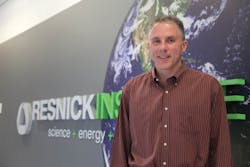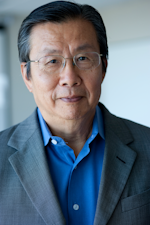Business Forum: The study of energy and sustainability reveals many opportunities in photonics

I interviewed Professor Harry Atwater Jr. of the California Institute of Technology (Caltech) because of the Institute's reputation for scientific and technical excellence. He is the Howard Hughes Professor of Applied Physics and Material Science and Director of the Resnick Institute for Science, Energy and Sustainability. He is also director of the DOE Energy Frontier Research Center on Light-Material Interactions in Solar Energy Conversion (LMI-EFRC). He is editor-in-chief of the journal ACS Photonics and his research interests center around photovoltaics and solar energy conversion, plasmonics, and optical metamaterials. He is also the founder of Alta Devices and Aonex.
Milton Chang: It is unusual that the Resnick Institute is funded by private donations. How big is the endowment and what is its purpose?
Harry Atwater: The Resnick Institute is Caltech's largest endowed research program. The total endowment is currently $37 million, spearheaded by a foundational gift from Lynda and Stewart Resnick. Scientific discovery and advancement is a core value of Caltech. So the Resnick Institute is committed largely to supporting significant advances in scientific fundamentals. People associate Caltech with fundamental advances in physics and chemistry in the 20th century. However, the areas that are most promising for scientific discoveries and advances in the 21st century are going to be interdisciplinary.
Climate change and energy security are two issues that have reached a level of importance to society and are also scientific drivers at Caltech. We have to find ways to generate inexpensive renewable energy and solve the problem of increasing carbon emissions, which are correlated to climate warming.
MC: Looking at the names of the two institutes, "Science, Energy, and Sustainability" is broad, whereas "Light-Material Interactions in Solar Energy Conversion" is specific. How do they differ?
HA: You can interpret the Resnick Institute as a sort of internal scientific venture capital fund at Caltech in the area of energy and sustainability. Federal support for fundamental, long-term science is declining nationwide, so we have to build up internal resources so we can seed and start projects that involve high risk.
The purview of the Resnick Institute is to be Caltech's resource for all aspects of energy and sustainability from management of the grid, to biofuels, to fuel cells, to sequestration of carbon, to advanced lightweight material for vehicles, as well as thermoelectric and solar cells. Unlike other sustainability institutes, we are not addressing policy, education, or economics; we really focus on the seminal science advances and technology developments that can enable the new component energy technology for the future.
The DOE Energy Frontier Research Center is a multi-university program among Caltech, Lawrence Berkeley National Laboratory, Stanford, Harvard, and the University of Illinois. This breadth allows us to draw on a group of the top people in the country whose scientific interests span both solar energy conversion and photonics.
MC: Describe a few exciting programs. Light/photonics seems to play a central role in almost every one of your endeavors.
HA: Breakthroughs and significant advances are being made at both institutes. Also, the Joint Center for Artificial Photosynthesis (JCAP) is a large DOE-sponsored effort that is working to understand the reduction of CO2 and oxidation to mimic photosynthesis so as to produce fuel in an engineered structure using only sunlight, water, and carbon dioxide as input. At JCAP another exciting program is focused on using sunlight to split water to create hydrogen fuel directly. We are making new materials to enable solar-to-hydrogen efficiency of a few percent and are laying foundations for a solar-hydrogen technology with >10% efficiency.
Francis Arnold, another Caltech energy scientist, has a vision to artificially create enzymes by directed evolution synthesis using DNA technology to produce biofuels much more efficiently. That is really exciting work because these are biologically based techniques for biofuel and green chemical production essentially at room temperature instead of at high temperatures and in a highly corrosive acidic environment in a chemical plant. Imagine being able to produce different fuels and chemicals at low temperatures with low energy consumption and neutral PH.
MC: What are the other research activities at LMI-EFRC?
HA: Our long-term goal is to serve as the national resource for fundamental optical principles and phenomena and for design of the optical properties of materials and devices for efficient energy conversion. We are creating new methods and architectures for complex photonic materials for solar energy conversion, including metamaterials, transformation optics, plasmonics, photonic crystals, and other dielectric-spectrum-splitting and light-trapping elements. The LMI-EFRC has fostered a world-leading capability for fabrication of complex three-dimensional photonic nanostructures and light absorbers.
MC: What do you think contributes to the success of a university with such a small enrollment (around 2300 students, grad and undergrad)?
HA: Caltech has an ideal environment to do interdisciplinary research. We have many if not all the science and engineering disciplines represented here and we are small enough to have almost no barrier to interdisciplinary work. Students can work on projects wherever they want. I have students from seven different academic departments in my group, from physics, applied physics, electrical engineering, chemical engineering, chemistry, mechanical engineering, and material science.
Students should bear in mind that it is important for undergraduates to get training in one discipline, but when you get to graduate school or in your working career, the biggest opportunities for career advancement and breakthroughs are going to be in interdisciplinary areas. Of course, Caltech also fosters and encourages depth as well as breadth.
MC: Can you give us a couple of examples of interdisciplinary projects?
HA: For example, John Dabiri's work on compact vertical wind turbine arrays came from insights about the hydrodynamics of fish schooling, allowing him to figure out how wind turbines interact with one another to get more than an order of more wind energy per area of land than using conventional horizontal axis turbines.
Also, Resnick graduate fellow Matt Smith, who worked with Frances Arnold on biofuels, was trained as a computer scientist to use informatics to figure out how to read the DNA block functional description of artificial genes, which code to make artificial proteins and enzymes that catalyze biofuel production. So Matt's work illustrates how developing new mathematical tools allows you to bypass doing a massive number of experiments to yield new successful proteins.
MC: What advice do you have for aspiring entrepreneurs?
AW: Alta Devices was a venture-backed company I co-founded in Santa Clara. From this and other start-up experiences, I have learned there are at least five things that are important to a venture: team, technology, IP, market, and financing. Technical entrepreneurs usually tend to concentrate only on technology; it turns out that the other four things are equally if not more important!

Milton Chang
MILTON CHANG of Incubic Management was president of Newport and New Focus. He is currently director of mBio Diagnostics and Aurrion; a trustee of Caltech; a member of the SEC Advisory Committee on Small and Emerging Companies; and serves on advisory boards and mentors entrepreneurs. Chang is a Fellow of IEEE, OSA, and LIA. Direct your business, management, and career questions to him at [email protected], and check out his book Toward Entrepreneurship at www.miltonchang.com.